Algebra | Chapter 3 | 8th Maths - Factorisation | 8th Maths : Chapter 3 : Algebra
Chapter: 8th Maths : Chapter 3 : Algebra
Factorisation
Factorisation
Expressing any number as the product of two or more numbers is called as factorisation. The number 12 can be expressed as the product of prime factors like 12 = 2 × 2 × 3. This is called prime factorisation. How will you factorise an algebraic expression? Yes. Expressing an algebraic expression as the product of two or more expressions is called the Factorisation.
Note
A number which is divisible by 1 and itself (or) A number which has
only 2 factors are called prime numbers. Example: 2, 3, 5, 7, 11, ...
A number which has more than 2 factors are called composite numbers.Example:
4, 6, 8, 9, 10, 12, ...
For example,
(i) a 2 −
b2 =
(a + b)(a − b)
Here, (a +
b) and (a − b) are the two factors
of a 2 −
b2
(ii) 5y + 30 = 5( y + 6) , Here 5 and ( y
+
6) are the factors of 5y + 30
Any expression
can be Factorised as (1) × (expression)
For example,
a2 −
b2 can also be factorised as
(1)
×
(
a 2 −
b2 ) or
(
−1)
×
(b2 − a2
)
because ‘1’
is a factor for all numbers and expressions
So, when
we factorise the expressions, follow the suitable type of factorisation given below
to get two or more factors other than 1. Stop doing the factorisation process once
you have taken out all the common factors from the expression and then list out
the factors.
Type 1: Factorisation by taking out the common factor from
each term.
Type 2 : Factorisation by taking out the common binomial
factor from each term
Type 3 : Factorisation by grouping
Type 4 : Factorisation using identities
Type 5 : Factorisation of the expression (ax2 + bx + c)
Type 1:
Factorisation by taking out the common factor from each term.
Example 3.18
Factorise:
4x 2 y + 8xy
Solution:
We have,
4x 2 y + 8xy This can be written
as,
= (2 × 2 × x
×
x × y
) +
(2 ×
2 ×
2 ×
x × y)
Taking out
the common factor 2, 2, x , y , we get
= 2 × 2 × x
×
y(x
+
2)
= 4xy(x + 2)
Type 2
: Factorisation by taking out the common binomial factor from each term
Example 3.19
(i) Factorise:
(2x + 5)(x − y ) +
(4 y)(x − y)
Solution:
We have (2x + 5)(x − y ) +
(4 y)(x − y)
Taking out
the common binomial factor (x −
y)
We get, (x − y)(
2x + 5 + 4 y)
(ii) Factorise
3n( p − 2) + 4(2 − p)
Solution:
We have 3n( p − 2) + 4(2 − p) (taking – as common)

3n( p
−
2) −
4( p − 2)
Taking out
the common binomial factor ( p −
2)
We get, (
p − 2)(3n − 4)
Type 3
: Factorisation by grouping
Sometimes,
the terms of a given expression are grouped suitably in such a way that they have
a common factor so that the factorisation is easy to take out common factor from
those terms.
Example 3.20
Factorise
: x2 +
yz + xy + xz
Solution:
We have,
x2 +
yz + xy + xz
Group the
terms suitably as,
= ( x 2 +
xy ) + ( yz + xz)
= x (x
+ y )
+ z( y + x)
= x (x
+ y )
+ z(x + y) (addition is
commutative)
= (x + y)[
x + z] [taking out the common factor (x + y) ]
Type 4
: Factorisation using identities
(i) (a + b)2
=
a 2 +
2ab + b2
(ii) (a − b)2
=
a 2 −
2ab + b2
(iii) a 2 −
b2 =
(a + b)(a − b)
Example 3.21
Factorise
: x 2 +
8x +16
Solution:
Now, x 2 +
8x +16 can be written as
x 2 +
8x + 42
Comparing
this with a 2 +
2ab + b2
=
(a + b)2
we get a = x ; b = 4
(x2) +
2(x)(4) +
(4)2 = ( x + 4)2
x 2 + 8x + 16 = ( x + 4)2
(x+4), (x+4) are the two factors.
Example 3.22
Factorise
49x 2 −
84xy + 36 y2
Solution:
Now, 49x 2 −
84xy + 36 y2
72
x2 −
84xy + 62 y2 = (7x)2 −
84xy + (6 y)2
Comparing
this with a2 −
2ab + b2
= (a − b)2 we get a = 7x , b = 6 y
(7x)2 −
2(7x)(6 y) + (6 y)2 = (7x − 6 y)2
∴
49x2 −
84xy + 36 y2= (7x − 6 y)2
(7x–6y),
(7x–6y) are the two factors.
Try these
Find the factors
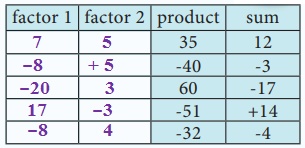
Example 3.23
Factorise
: 49x2 −
64 y2
Solution:
Now, 49x2 −
64 y2
72
x2 −
82 y2 = (7x)2 −
(8y)2
Comparing
this with a2 −
b2 =
(a + b)(a − b)
we get a = 7x ,
b = 8y
(7x)2 −
(8 y)2 =
(7x + 8 y)(7x −
8 y)
(7x+8y),
(7x–8y) are the two factors.
Type 5
: Factorisation of the expression (ax2
+ bx + c)
Example 3.24
Factorise
x2+ 8x+15
Solution:
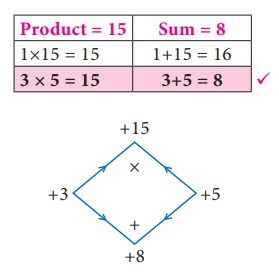
Given x2 + 8x +15
This is in
the form of ax2 +
bx + c
We get a = 1,b = 8, c =
15
Now, the
product =
a × c
and sum =
b b = 8
=1×15
= 15
= x2 +
8x +15
= x2 + 3x + 5x + 15 (the middle term 8x
can be written as 3x+5x)
= (x2 +
3x) + (5x +15)
= x(x
+ 3) + 5(x + 3) taking out the common
factor x+3 )
x2 + 8x
+ 15 = ( x + 3)(x + 5)
Therefore,
(x+3), (x+5) are the two factors.
Think
x2–4(x–2) = (x2–4)(x–2)
Is this correct? If not correct it.
Solution:
Not correct
(3a)2 = 32a2 − 9a2
x2 − 4(x − 2) = x2 – 4x + 8
Example 3.25
Factorise
7c2 +
2c – 5
Solution:
Given

This is in
the form of ax2 + bx
+ c
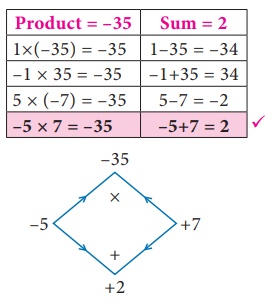
We get a = 7, b = 2, c = −5
Now, the
product =
a × c
=
7 ×
(−5)
= –35 and sum b = 2
= 7c 2 +
2c – 5
= 7c 2 – 5c + 7c
– 5
(the middle term 2c can be written as –5c+7c)
= (7c 2 − 5c) + (7c − 5)
= c (7c − 5) + 1(7c − 5) (taking out the common
factor 7c–5 )
= (7c − 5)(c + 1)
Therefore,
(7c–5), (c+1) are the two factors.
Try these
Factorise the following :
1) 3y + 6
2) 10x 2 +15y2
3) 7m(m − 5) + 1(5 − m)
4) 64 − x2
5) x2–3x+2
6) y2–4y–32
7) p2+2p–15
8) m2+14m+48
9) x2–x–90
10) 9x2–6x–8
Solution:
1. 3y + 6
3y + 6 = 3 × y + 2 × 3
Taking out the common factor 3 from each term we get 3 (y
+ 2)
∴ 3y + 6 = 3(y + 2)
2. 10x2 + 15y2
10x2 + 15y2 = (2 × 5 × x
× x) + (3 × 5 × y × y)
Taking out the common factor 5 we have
10x2 + 15y2 = 5(2x2 + 3y2)
3. 7m (m − 5) + (15 – m)
7m (m − 5) + (15 – m) = 7 m (m
− 5) + (−1 )(−5 + m)
= 7m (m − 5) − 1(m − 5)
Taking out the common binomial factor (m − 5) = (m
− 5) (7 m − 1)
4. 64 − x2
64 − x2 = 82 − x2
This is of the form a2 − b2
Comparing with a2 − b2 we
have a = 8, b = x
a2− b2 = (a + b) (a − b)
64 − x2 = (8 + x) (8 − x)
5. x2 – 3x + 2
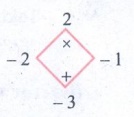
x2 – 3x + 2 = x2 − 2x − x
+ 2
= x (x − 2) − (x − 2)
= (x − 2) (x − l)
6. y2 – 4y – 32
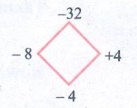
y2 – 4y – 32 = y2 – 8y + 4y
− 32
= y(y − 8) + 4(y − 8)
= (y − 8) (y + 4)
7. p2 + 2p – 15
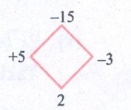
p2 + 2p – 15 = p2
+ 5p −3p − 15
= p(p + 5) −3 (p + 5)
= (p + 5) (p − 3)
8. m2 + 14 m + 48
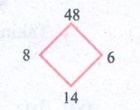
m2 + 14 m + 48 = m2 + 8 m + 6 m
+ 48
= m (m + 8) + 6 (m + 8)
= (m + 6) (m + 8)
9. x2 − x – 90
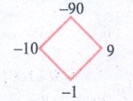
x2 − x – 90 = x2 − 10x + 9x
− 90
= x (x − 10) + 9 (x − 10)
= (x + 9) (x − 10)
10. 9x2 − 6x – 8

9x2 − 6x – 8 = 9x2
− 12x + 6x − 8
= 3x (3x − 4) + 2(3x − 4)
= (3x + 2) (3x − 4)